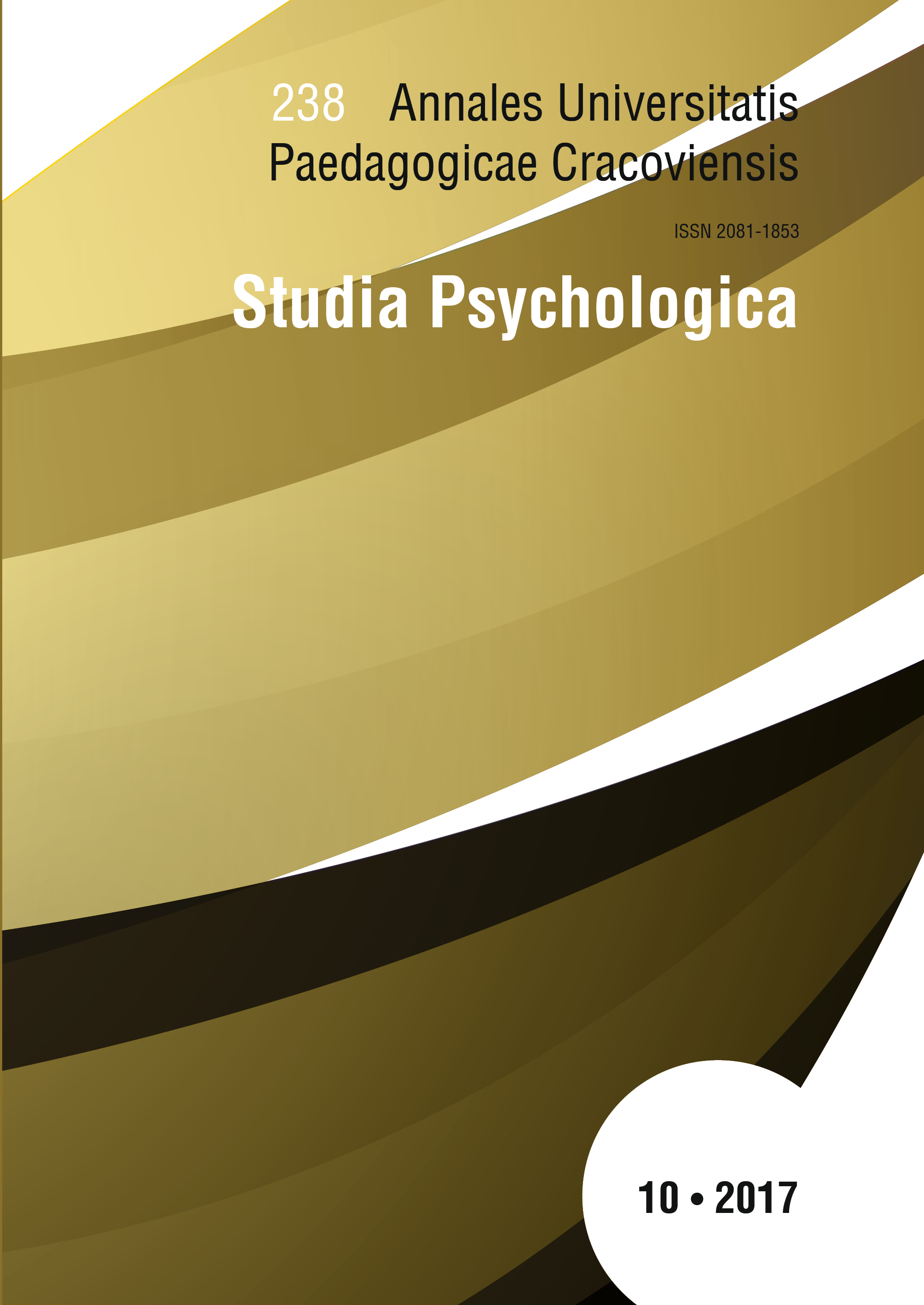Pilot Test of the Growth Resources Questionnaire
Keywords:
resources, autonomy, belonging, emotions, questionnaireAbstract
In this paper, the results of a pilot test of a new diagnostic tool are presented. The Growth Resources Questionnaire (its Polish version) was developed on the basis of the Growth Resources Model - a new theoretical concept dedicated to grasping the key psychosocial resources responsible for personal development and flourishing (Pasowicz, 2017, in this volume). The questionnaire consists of three scales: The Positive Autonomy Scale, The Positive Belonging Scale, and The Positive Emotionality Scale. The questionnaire was tested on a sample of 304 subjects and its most important psychometric properties are presented and discussed. Finally, conclusions are drawn and further developments of the tool are outlined.References
Borucka,A.,& Ostaszewski,K.(2008).Koncepcjaresilience.Kluczowepojęciai wybranezagadnienia. Medycyna Wieku Rozwojowego, 12 (2),587-597.
Brzezińska,A.I.(2005).Jak przebiega rozwój człowieka? In A.I.Brzezińska (Ed.),Portrety psychologiczne człowieka (pp.21-39).Gdańsk:Gdańskie Wydawnictwo Psychologiczne.
Brzezińska,A.I., Kaczan,R., Piotrowski,K.,& Rycielski,P.(2008).Uwarunkowania aktywności zawodowej osób z ograniczeniami sprawności:czynniki powodzenia i czynniki ryzyka. Nauka, 4, 77-100.
Charney, D.S. (2004). Psychobiological mechanisms of resilience and vulnerability:implications for successful adaptation to extreme stress. American Journal of Psychiatry, 161,195-216.
Deci, E.L., & Ryan, R. (2008). Self-Determination Theory: A Macrotheory of HumanMotivation, Development, and Health. Canadian Psychology, 49 (3),182-185.DOI: 10.1037/a0012801.
Ekman,P.(1992).An Argumentfor Basic Emotions,Cognition and emotion, 6 (3/4),169-200.
Erikson,E.H.(1998).The Life Cycle Completed.NewYork:WW Norton & Company.
Fredrickson,B.L.(1998).What Good Are Positive Emotions? Review of General Psychology, 2 (3), 300-319. DOI:10.1037/1089-2680.2.3.300.
Fredrickson, B.L. (2001). The role of positive emotions in positive psychology: the broaden-and-build theory of positive emotions. American Psychologist, 56 (3), 218-276.
Fredrickson,B.L.(2003).The Value of Positive Emotions.American Scientist, 91,330-335.
Fredrickson,B.L.(2013).Updated Thinking on Positivity Ratios.American Psychologist. Advance online publication, 1-9.DOI:10.1037/a0033584.
Fredrickson, B.L., & Branigan, Ch. (2005). Positive Emotions Broaden the Scope of Attention and Thought-Action Repertoires. Cognition and Emotion, 19 (3), 313-332.
Fredrickson, B.L., Mancuso, R.A., Branigan, Ch., & Tugade, M.M. (2000). The Undoing Effect of Positive Emotions.Motivation and Emotion, 24 (4),237-258.
Gross,J.J.(1999).EmotionRegulation:Past,Present,Future.Cognition and Emotion, 13 (5),551-573.
Heinrichs,M.,Baumgartner,T.,Kirschbaum,C.,&Ehlert,U.(2003).Social Support and Oxytocin Interact to Suppress Cortisol and Subjective Responses to Psychosocial Stress.Society of Biological Psychiatry.DOI:10.1016/S0006-3223(03)00465-7.
Heszen,I.,&Sęk,H.(2007).Psychologia zdrowia.Warszawa:PWN.
Jarymowicz,M.,&Imbir,K.(2010).Próbataksonomiiludzkichemocji.Przegląd psychologiczny, 53 (4),439-461.
Karaś,D.,Cieciuch,J.,&Keyes,C.L.M.(2014).The Polish adaptation of the Mental Health Continuum-ShortForm(MHC-SF).Personality and Individual Differences, 69, 104-109.
Keyes, C.L.M. (2002). The Mental Health Continuum: From Languishing to Flourishing in Life. Journal of Health and Social Research, 43, 207-222.
Larsen, J.T., McGraw, A.P., & Cacioppo. J.T. (2001). Can people feel happy and sad at the same time? Journal of Personality and Social Psychology, 81, 684-696. DOI: 10.1037//0022-3514.81.4.684.
Luthar,S.,Cicchetti,D.,& Becker,B.(2000).The construct of resilience:critical evaluation and guidelines for future work. Child Development, 71,543-562.
Ogińska-Bulik,N.,&Juczyński,Z.(2008).Skala pomiaru prężności.Nowiny Psychologiczne, 1 (3),39-55.
Ochsner,K.N.,&Gross,J.J.(2010).Thinking makes it so:A social cognitive neuroscience approach to emotion regulation.In K.Vohs, R.Baumeister(Eds.).The Handbook of Self-Regulation.NewYork: The Guilford Press.
Pasowicz, M. (2017). Introduction to the Growth Resources Model. Annales Universitatis Paedagogicae Cracoviensis. Studia Psychologica, 10, 23-38.
Plutchik, R. (1980). Emotion: A psychoevolutionary synthesis.NewYork:Harper and Row.
Reich.J.W.,Zautra,A.J.,&Davis,M.(2003).Dimensions of Affect Relationships:Models and Their Integrative Implications. Review of General Psychology, 7 (1),56-83.DOI: 10.1037//1089-2680.7.1.66.
Seligman,M.E.P.,& Csikszentmihalyi,M.(2000).Positive Psychology. AnIntroduction. American Psychologist, 55 (1),5-14.DOI:10.1037//0003-066X.55.1.5.
Semmer, N. (2006). Personality, stress and coping. In M. Vollrath (Ed.), Handbook of Personality and Health (pp. 73-113). Chichester: Wiley.
Watson,D.,Wiese,D.,Vaidya,J.,&Tellegen,A.(1999).The Two General Activation Systems of Affect: Structural Findings, Evolutionary Considerations and Psychobiological Evidence. Journal of Personality and Social Psychology, 76 (5), 820-838. DOI: 10.1037/0022-3514.76.5.820.
Brzezińska,A.I.(2005).Jak przebiega rozwój człowieka? In A.I.Brzezińska (Ed.),Portrety psychologiczne człowieka (pp.21-39).Gdańsk:Gdańskie Wydawnictwo Psychologiczne.
Brzezińska,A.I., Kaczan,R., Piotrowski,K.,& Rycielski,P.(2008).Uwarunkowania aktywności zawodowej osób z ograniczeniami sprawności:czynniki powodzenia i czynniki ryzyka. Nauka, 4, 77-100.
Charney, D.S. (2004). Psychobiological mechanisms of resilience and vulnerability:implications for successful adaptation to extreme stress. American Journal of Psychiatry, 161,195-216.
Deci, E.L., & Ryan, R. (2008). Self-Determination Theory: A Macrotheory of HumanMotivation, Development, and Health. Canadian Psychology, 49 (3),182-185.DOI: 10.1037/a0012801.
Ekman,P.(1992).An Argumentfor Basic Emotions,Cognition and emotion, 6 (3/4),169-200.
Erikson,E.H.(1998).The Life Cycle Completed.NewYork:WW Norton & Company.
Fredrickson,B.L.(1998).What Good Are Positive Emotions? Review of General Psychology, 2 (3), 300-319. DOI:10.1037/1089-2680.2.3.300.
Fredrickson, B.L. (2001). The role of positive emotions in positive psychology: the broaden-and-build theory of positive emotions. American Psychologist, 56 (3), 218-276.
Fredrickson,B.L.(2003).The Value of Positive Emotions.American Scientist, 91,330-335.
Fredrickson,B.L.(2013).Updated Thinking on Positivity Ratios.American Psychologist. Advance online publication, 1-9.DOI:10.1037/a0033584.
Fredrickson, B.L., & Branigan, Ch. (2005). Positive Emotions Broaden the Scope of Attention and Thought-Action Repertoires. Cognition and Emotion, 19 (3), 313-332.
Fredrickson, B.L., Mancuso, R.A., Branigan, Ch., & Tugade, M.M. (2000). The Undoing Effect of Positive Emotions.Motivation and Emotion, 24 (4),237-258.
Gross,J.J.(1999).EmotionRegulation:Past,Present,Future.Cognition and Emotion, 13 (5),551-573.
Heinrichs,M.,Baumgartner,T.,Kirschbaum,C.,&Ehlert,U.(2003).Social Support and Oxytocin Interact to Suppress Cortisol and Subjective Responses to Psychosocial Stress.Society of Biological Psychiatry.DOI:10.1016/S0006-3223(03)00465-7.
Heszen,I.,&Sęk,H.(2007).Psychologia zdrowia.Warszawa:PWN.
Jarymowicz,M.,&Imbir,K.(2010).Próbataksonomiiludzkichemocji.Przegląd psychologiczny, 53 (4),439-461.
Karaś,D.,Cieciuch,J.,&Keyes,C.L.M.(2014).The Polish adaptation of the Mental Health Continuum-ShortForm(MHC-SF).Personality and Individual Differences, 69, 104-109.
Keyes, C.L.M. (2002). The Mental Health Continuum: From Languishing to Flourishing in Life. Journal of Health and Social Research, 43, 207-222.
Larsen, J.T., McGraw, A.P., & Cacioppo. J.T. (2001). Can people feel happy and sad at the same time? Journal of Personality and Social Psychology, 81, 684-696. DOI: 10.1037//0022-3514.81.4.684.
Luthar,S.,Cicchetti,D.,& Becker,B.(2000).The construct of resilience:critical evaluation and guidelines for future work. Child Development, 71,543-562.
Ogińska-Bulik,N.,&Juczyński,Z.(2008).Skala pomiaru prężności.Nowiny Psychologiczne, 1 (3),39-55.
Ochsner,K.N.,&Gross,J.J.(2010).Thinking makes it so:A social cognitive neuroscience approach to emotion regulation.In K.Vohs, R.Baumeister(Eds.).The Handbook of Self-Regulation.NewYork: The Guilford Press.
Pasowicz, M. (2017). Introduction to the Growth Resources Model. Annales Universitatis Paedagogicae Cracoviensis. Studia Psychologica, 10, 23-38.
Plutchik, R. (1980). Emotion: A psychoevolutionary synthesis.NewYork:Harper and Row.
Reich.J.W.,Zautra,A.J.,&Davis,M.(2003).Dimensions of Affect Relationships:Models and Their Integrative Implications. Review of General Psychology, 7 (1),56-83.DOI: 10.1037//1089-2680.7.1.66.
Seligman,M.E.P.,& Csikszentmihalyi,M.(2000).Positive Psychology. AnIntroduction. American Psychologist, 55 (1),5-14.DOI:10.1037//0003-066X.55.1.5.
Semmer, N. (2006). Personality, stress and coping. In M. Vollrath (Ed.), Handbook of Personality and Health (pp. 73-113). Chichester: Wiley.
Watson,D.,Wiese,D.,Vaidya,J.,&Tellegen,A.(1999).The Two General Activation Systems of Affect: Structural Findings, Evolutionary Considerations and Psychobiological Evidence. Journal of Personality and Social Psychology, 76 (5), 820-838. DOI: 10.1037/0022-3514.76.5.820.
Downloads
Published
2017-12-01
How to Cite
Pasowicz, M. (2017). Pilot Test of the Growth Resources Questionnaire. Annales Universitatis Paedagogicae Cracoviensis Studia Psychologica, 10(1), 39–60. Retrieved from https://studia-psychologica.uken.krakow.pl/article/view/5639
Issue
Section
Articles

